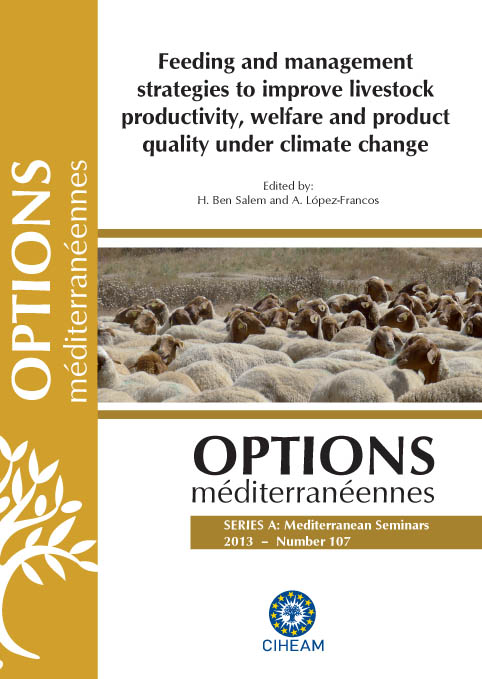| Article précédent | p. 283-287 | Article suivant |
Effect of polyethylene glycol addition on methane production from some Algerian browse plant species in an in vitro gas system
Biological activity of tannins of different browse plants was measured as the change in methane production when plant material was incubated with and without polyethylene glycol (PEG) using the in vitro gas production technique. Four dicotyledon browse plants (Atriplex halimus, Artemisia campestris, Artemisia herba-alba, Calobota saharae) and three monocotyledon browse plants (Stipagrostis pungens, Lygeum spartum and Stipa tenacissima), collected from an arid zone in Bousâada were evaluated. The increase in gas production upon the addition of PEG, compared with that without PEG, for the browse species varied widely (P<0.05), being particularly high in S. tenacissima (+35.0%) and low in L. spartum (+1.5%). The methane concentration in fermentation gas ranged from 7.9% with A. halimus to 18.6% with L. spartum. The higher increase in methane percentage was noted for S. tenacissima (+47.4%) and the lower percent value was observed for L. spartum (+1.5%). In presence of PEG, the methane production had positive correlation with crude protein (r = +0.78) while in absence of PEG, the methane production was correlated negatively with total condensed tannins (r = -0.88). The strongest correlation (r = 0.89; P<0.01) was between total condensed tannins and methane increase response to the addition of polyethylene glycol, suggesting that tannin compounds appeared to be useful to identify plants possessing antimethanogenic activity.
L’activité biologique des tanins de diverses plantes par le microbiote ruminal d’ovins est mesurée in vitro, en présence et en absence de polyéthylène glycol (PEG). La fermentescibilité des substrats est évaluée par la production de gaz, retenus comme marqueurs métaboliques. L’étude est menée sur 4 plantes dicotylédones (Atriplex halimus, Artemisia campestris, Artemisia herba-alba, Calobota saharae) et 3 plantes monocotylédones (Stipagrostis pungens, Lygeum spartum et Stipa tenacissima), collectées de zones arides d’Algérie (Bousâada). Une augmentation nette de la production de gaz est constatée en présence de PEG (P<0,05). Elle est particulièrement élevée pour S. tenacissima (+35,0%) et faible pour L. spartum (+1,5%). Dans le pool gazeux fermentaire, la production de méthane varie de 7,9 % pour A. halimus à 18,6% pour L. spartum. Son augmentation la plus élevée est notée pour S. tenacissima (+47,4%) et la plus faible pour L. spartum (+1,5%). En présence de PEG, la production de méthane est corrélée positivement avec la matière azotée totale (r = +0,78), en son absence la production est corrélée négativement avec les tanins condensés totaux (r = -0,88). La forte corrélation, (r = 0,89 ; P<0,01), observée entre les tanins condensés totaux et l’augmentation de la production de méthane, en réponse à l’addition du PEG, suggère que le test des tanins couplé à la production de gaz peut être un moyen efficace pour identifier les plantes possédant des activités anti-méthanogènes.
- [ Afficher ]
- [ Télécharger ]
- [ Exporter la citation ]
Vous pouvez télécharger la citation au format :
- [ Imprimer ]
-
Mots-clés
COMPOSITION CHIMIQUE, METHANE, PLANTE D'ABROUTISSEMENT, RUMEN, TANNINCiter cet article
Boufennara S., Bouazza L., López S., Bousseboua H., Bodas R. Effect of polyethylene glycol addition on methane production from some Algerian browse plant species in an in vitro gas system. In : Ben Salem H. (ed.), López-Francos A. (ed.). Feeding and management strategies to improve livestock productivity, welfare and product quality under climate change. Zaragoza : CIHEAM / INRAT / OEP / IRESA / FAO, 2013. p. 283-287. (Options Méditerranéennes : Série A. Séminaires Méditerranéens; n. 107). 14. International Seminar of the Sub-Network on Nutrition of the FAO-CIHEAM Inter-Regional Cooperative Research and Development Network on Sheep and Goats, 2012/06/15-17, Hammamet (Tunisia). http://om.ciheam.org/om/pdf/a107/00007047.pdf



